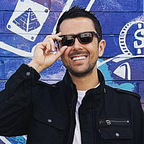Beginners guide to Blockchain Part III: What is Ethereum?
Let’s talk about this bad boy: Ethereum.
But before we do that I truly hope you’ve read the previous 2 parts of this article series: What is Bitcoin? and What is Blockchain? — If you haven’t just click on those links and check them out. Now, let’s get started.
Ethereum is the second largest crypto-currency by market capitalization right after Bitcoin. It was first introduced in 2013 at the North America Bitcoin Conference by a young Ukrainian programmer raised in Canada, Vitalik Buterin.
Vitalik felt that blockchain technology should not only be used as a store of value (like bitcoin) but that it should also allow for more assets or information to be attached to each transaction in the chain so a it could also be used as a platform to build something called Dapps (Decentralized Applications).
So… What is Ethereum?
Ethereum is a decentralized, open source, and distributed computing platform that enables the creation of smart contracts and decentralized applications on the Ethereum Blockchain. Smart contracts are computer protocols that facilitate, verify, or enforce the negotiation and performance of some sort of agreement.
So not only is Ethereum a chain of it’s own, it has it’s own token called Ether, it is a store of value, but it is also a platform where you can build things on top of it and this last part is massive, probably one of the biggest revolutions inside the crypto ecosystem.
Let’s put it this way if Bitcoin is the “new gold”, Ethereum would be the “new Internet” or “Web 3.0” due to its capacity as a platform as well.
Here are a few key concepts you should understand regarding the Ethereum ecosystem so you are not caught of guard.
Ethereum = The name of the blockchain.
Ether = The name of this blockchain’s token.
WEI = The smallest denomination of Ether (1 Ether = 1,000,000,000,000,000,000 WEI, like the cents for a dollar or a Satoshi for Bitcoin).
EVM / Ethereum Virtual Machine = The software that runs Ethereum.
Solidity = The programming language of the Ethereum Blockchain.
Etherscan = The online transparency provider of Ethereum where you can literally scan every transaction on the chain.
Dapp = Decentralized application.
Here is another interesting fact about Ethereum history:
ETH has become one of the most accepted project by mainstream institutions, having massive names like JP Morgan, Citibank and more joining something called The Enterprise Ethereum Alliance to further develop the project and it’s endless opportunities — It actually has had way more mainstream acceptance than it’s “bigger brother” Bitcoin.
But something “funny” (or horrible some might say) happened in 2016 when a group of entrepreneurs created an Ether-based venture fund called “The DAO”. The DAO was not a typical venture fund because it was a Decentralized Autonomous Organization (you can read more about this concept here).
The DAO raised $150,000,000 USD in Ether very quickly through a token sale. Unfortunately The DAO’s code was compromised, hacked and most of the money was stolen. This created a huge division within the Ethereum community having a part of it agree that the Ethereum’s chain needed a code updated for further protection and another part claim that it did not need it.
This led to what is called a “Hard Fork” in the industry. A moment where a token is either divided in 2 new tokens for update purposes or it simply changes its name, creating a new token and forgetting about the old one. This is why in many exchanges you will see Ethereum Classic (the pre-fork version) and Ethereum (the post-fork version) — Do you want the whole gossip on this very juicy piece of Ethereum history? Read it here.
And one last thing: Ethereum has a gas problem.
Yes, that is not a bad joke (well kind of…) but it does have a gas problem. Gas is a term that refers to the commission the Ethereum network charges with every transaction to pay miners supporting the project.
The problem is that the more the platform is used, the higher the gas fees are, sometimes to a point where it is ridiculous. I’ve personally had to pay gas fees of $200 USD por a $500 USD transaction. Vitalik and the Ethereum team are currently working on how to solve this.
Now you know a little bit more about Ethereum. It is one of the most exciting things happening in the crypto ecosystem and we will for sure be talking more about it in the future.
Enjoyed this article? Follow me on twitter at @thechrispace and let me know what you think of it.
Chris Pace.
